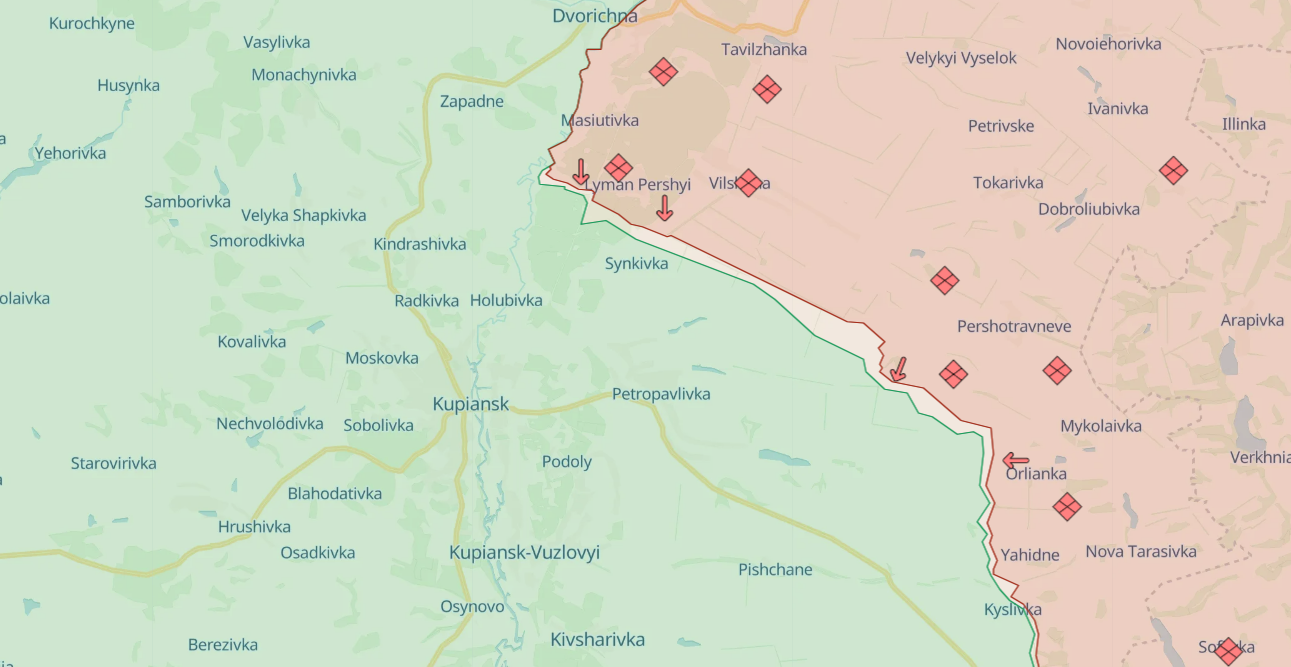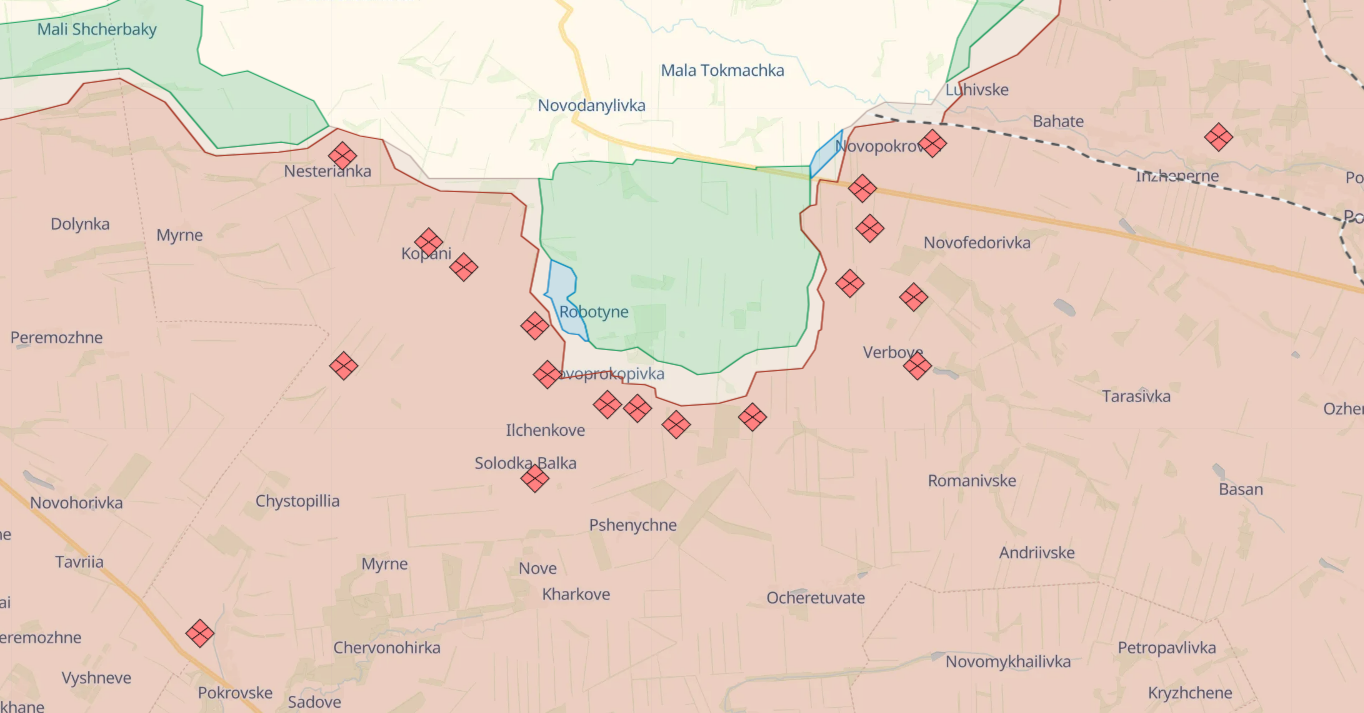Avdiivka draining Russian resources: How Ukraine defends East and expands its foothold
 Autumn slows down hostilities, intensification may come already in winter (photo GettyImages)
Autumn slows down hostilities, intensification may come already in winter (photo GettyImages)
Ukrainian troops are restraining the Russian offensive on Avdiivka and Kupiansk, while at the same time gaining a foothold on the left bank of the Kherson region.
Sources used: summary of the General Staff of the Armed Forces of Ukraine, analysts of the American Institute for the Study of War (ISW) and the Ukrainian DeepState project, statements of official military speakers, as well as comments of experts Oleksandr Kovalenko, Oleksandr Musiienko and Vladyslav Seleznov.
Despite huge losses, the Russians make their way to Avdiivka, attacking from the flanks and through industrial zones. At the same time, positions are being stormed in the direction of Kupiansk, as well as in the south of Donetsk and Zaporizhzhia regions. The only area where good news is coming from is the left bank of the Kherson region, where the Ukrainian Armed Forces are entrenched on bridgeheads. All this is happening against the background of a shortage of resources, which jeopardizes the success of offensive and defensive operations.
Avdiivka is on fire. The Russians are storming, the Ukrainian Armed Forces hold on
Russian troops again stepped up in the direction of Avdiyivka. According to the head of the city's military administration, Vitalii Barabash, it is hot now in the area of the industrial zone of the Avdiivka Coke and Chemical Plant (ACCP), the city itself is being bombarded by aviation and artillery.
"Every day they hit the city. Mainly on high-rise buildings," he says.
According to DeepState reports, the defenses in the southern industrial zone on the side of Yasynuvata have been breached, and it is only a matter of time before the occupiers move into new positions. There are no official comments from the military.
"According to the latest reports, the Ukrainian army counterattacked north of Avdiivka, pushing the Russians away from Stepove. Of course, the "fog of war" does not work for those who want to understand in detail what is happening on the front. This may be because the people in the epicenter have segmented information, and those authorized for official communication have certain restrictions. Or they specifically take a break so as not to create problems for the defenders of Avdiivka," expert, former speaker of the General Staff of the Armed Forces of Ukraine Vladyslav Seleznov told RBC-Ukraine.
In his opinion, the prospects may not be the best, as the supply of military equipment has decreased recently. The real state of affairs is unlikely to become known in the coming days, but you cannot fight tanks with your bare hands.
 The Russians are attacking Avdiivka from the flanks and beyond (photo deepstatemap.live)
The Russians are attacking Avdiivka from the flanks and beyond (photo deepstatemap.live)
The enemy is powerfully storming the ACCP industrial zone, and he already has the opportunity to enter it.
"But, on the other hand, the Russians cannot gain a foothold there, our forces are constantly knocking them out of there with counterattacks. As for the line in the south of Avdiivka, they are pushing through Vynohradnyky and, accordingly, have taken positions in this area and along Yasynuvatskyi Lane," emphasizes Oleksandr Kovalenko, military and political columnist of the "Information Resistance" group.
To the north of the city, the Russians press near Novokalynove and Vesele, transfer reinforcements to Krasnohorivka, and try to approach the dachas near the territory of the ACCP. On the southern flank, they are attacking from Vodyane in the direction of Tonenke and Severne, storming our positions in Pervomaiske.
Last week, a video of a kamikaze tank appeared, and BILD columnist Julian Röpke suggested that the occupiers managed to penetrate the industrial zone for the first time in this way. Later, the General Staff clarified that it was a lightly armored tractor and exploded as a result of hitting a mine, not an attack by FPV drones. In this connection, there were fears that the enemy, due to heavy losses, was betting on a new tactic: blowing up armored vehicles filled with explosives on Ukrainian positions. But it also does not work because of large minefields.
"They adopted this tactic in ISIS, it was widely used in Syria and not for the first time in Ukraine. A tank is filled with explosives and directed in a straight line. If we talk about attacking a specific position, then this is a really serious weapon. But in most cases, they are destroyed on approach or they explode on mines themselves," Kovalenko explains.
During the month of assaults, the enemy lost more than 10,000 soldiers. President Volodymyr Zelenskyy calls such rates faster and larger than what happened under Bakhmut. Due to constant shelling, Avdiivka turned into ruins, and about 1,400 residents are still not ready to leave.
Kupiansk remains the target of the Russians but without prospects
The Russian command is throwing more and more forces at Kupiansk (Kharkiv region). Assault operations are concentrated in the Synkivka area and east of Petropavlivka. From the front line to the city border is a little more than 6 km, now the fighting is taking place in the forest area.
"The adversary is trying to find weak points in the Ukrainian defense. Regrouping is underway," says Volodymyr Fityo, spokesperson for the Ground Forces Command of the Ukrainian Armed Forces, adding that the Russians are increasingly striking with guided air bombs.
The defense of Kupiansk is important because, in case of success, the Russians can occupy not only the city but also reach the eastern bank of the Oskil River within the Kharkiv region. Oleksandr Musiienko, head of the Center for Military Legal Studies, believes that there are not many threats in this area. According to him, the situation has not changed much for several months. The enemy accumulates forces, goes on the attack, our troops repulse it, and if the Russians achieve minor tactical successes, they are still forced to stop the offensive.
 Another round of escalation near Kupiansk (photo deepstatemap.live)
Another round of escalation near Kupiansk (photo deepstatemap.live)
"This is just another round of escalation with an emphasis on manpower. Plus, the weather interferes, and the occupiers themselves complain about it. I think that here we will confidently restrain the enemy since he has much less strength than there was a month or two ago," he says in conversation with the agency
Oleksandr Kovalenko agrees that the Russians do not have much chance either in occupying Kupiansk or in reaching Oskil through the Lyman-Kupiansk axis. According to him, their "Center" group has lost its most combat-ready units. These are units of the 90th Tank Division, as well as the 2nd and 41st combined armies of the Russian Armed Forces.
"Almost all of them were sent near Avdiivka, and there are no opportunities to go to Oskil. They will continue to press Kupiansk, they have a numerical advantage, but, on the other hand, the Defense Forces of Ukraine have built serious fortified areas, for the breakthrough of which much more powerful resources are needed. And they can't afford it, because Avdiivka absorbs all the resources," the expert adds.
To the south, the occupiers advanced a little from the side of Kreminna, analysts record minor successes in the forest massif. In the direction of Lyman, reserves are being drawn up, groups are forming and preparations are being made for offensive operations. On the southern flank near Bakhmut, they increased the intensity of assaults near Klishchiivka and approached the dominant height of 215.7. This threatens huge problems, but the General Staff reassures - the enemy's attempts are unsuccessful.
The southern front moved to the trenches
During the summer counter-offensive, the Defense Forces of Ukraine managed to cut off the so-called Vremivsky ledge south of Velyka Novosilka, advance 8 kilometers in the Robotyne region, and liberate several villages near occupied Vasylivka. But powerful lines and continuous minefields did not allow to break through the defenses on the 200-km section from Maryinka in the Donetsk region to the Kakhov reservoir.
The front line near Robotyne is sluggish, and in its current form, the bridgehead for the further advance to Tokmak risks turning into a sack of fire. To prevent this, it is necessary to expand the flanks and occupy the heights.
"Unfortunately, we have to state not only Ukrainian attacks but also enemy counterattacks that are successful at the tactical level. Moreover, the battles here are taking place near the first Surovikin line (the line of defense of the occupiers, - ed.). Our gains are several kilometers in four months are quite modest. General Valerii Zaluzhnyi said in one of the interviews that the calculations were completely different," says Vladyslav Seleznov in a conversation with RBC-Ukraine.
 The front line near Robotyne is inactive, the troops went into the trenches (photo deepstatemap.live)
The front line near Robotyne is inactive, the troops went into the trenches (photo deepstatemap.live)
There are signs of trench warfare on the southern front. This, however, does not mean that the Ukrainian counteroffensive is complete.
"I cannot yet say that our counteroffensive has come to an end, it's just that the format of hostilities is changing to a classic positional war. We are advancing, but very slowly," Oleksandr Kovalenko adds.
Last week, it became known about the first use by the Russians of corrected cluster aerial bombs RBK-500 near Staromayorske (Donetsk region). Each of them contains more than 500 submunitions with a coverage area much larger than that of the cluster projectiles in service with the Armed Forces.
"Indeed, this is a serious threat. If we are talking about an aerial bomb of the FAB-500 type, then it hits point-wise, and the RBK-500 covers a large area. And even if it is possible to disrupt its navigation by EW systems, even after detonating 200 meters from the specified coordinates, its elements will still reach the positions," the expert explains.
Ukrainian Armed Forces is on the left bank of the Kherson region. It is too early to say about the attack
Ukrainian bridgeheads on the left bank of the Kherson region have finally ceased to be Polyshinel's secret. Last week, the Marines confirmed that the fighters had conducted a series of successful operations and established themselves in several areas on the other side of the Dnipro River.
According to DeepState maps, the grey zone stretched from Oleshky almost to Nova Kakhovka along the first line of defense of the Russians and the road through the settlements of Krynky, Kozachi Laheri, Pishchanivka, etc. In some places, it cut the road, and near Krynky it entered a forest, behind which the main logistical artery is the T2206 route through the entire occupied part of the region to Melitopol.
According to statements by the General Staff, the Marines work on enemy logistics and conduct sabotage, raids, and reconnaissance to identify supply routes, personnel locations, equipment, and artillery positions. It is also emphasized that one of the main goals is to push the Russians away from Kherson and from the right bank in general.
 The "grey zone" on the left bank of the Dnipro River stretched from Oleshky to Nova Kakhovka (photo deepstatemap.live)
The "grey zone" on the left bank of the Dnipro River stretched from Oleshky to Nova Kakhovka (photo deepstatemap.live)
The bridgehead on the left bank is interesting not only because it is 70 km from Crimea. This is probably the only area where our troops can conduct flanking and maneuver operations.
"The goal is to enter the enemy's rear with all the negative consequences for them: cutting logistics, destroying warehouses and supply lines, forced transfer of personnel from other directions. And this is real because, despite the grouping of more than 60,000 occupiers, our marines managed to find weak points," says Oleksandr Musiienko.
Official sources give information about bridgeheads in doses. Natalia Humeniuk, spokesperson of the Southern Defense Forces, explains: that the site is complex, and not all work is subject to publicity. According to her, the Russians were pushed back from the Dnipro River to a distance of 3 to 8 kilometers. Provided that the fighters operated without armored vehicles, successes are serious, Vladyslav Seleznov believes. But now the troops will not be able to move further into the occupied territories.
"Because they need to feel artillery support. And for them to feel it, artillery systems, ammunition, air defense equipment, and armored vehicles must be moved from the right bank to the left. When will this happen? Only after we built a pontoon-bridge crossing. Regarding the response time frame I don't have any, this mission is already too complicated in terms of engineering and in terms of how to secure the crossing from enemy aircraft and artillery. Therefore, it is not worth counting on the fact that the bridgeheads will soon reach the Crimean isthmus," he emphasizes.
The experts interviewed by RBC-Ukraine, commenting on the situation on the left bank of the Kherson region, do not expect a quick major offensive. For the reason that it took almost a year to create the current bridgeheads, and so far the priority is the safety buffer. It will be possible to use it for a conditional campaign to Crimea only in the future, which is too early to talk about.
"Initially, the transfer of troops across the Dnipro River and the provision of fire cover. After this is done, if at all the possibility arises, because the enemy is strengthening the defense, whether our forces will succeed or not, then it will be possible to make predictions. Or it will be an advance to the rear, or taking the bridgehead under fire control. To return to offensive actions in the spring, perhaps with better support," Musiienko adds.
***
The situation at the front is difficult: constant Russian attacks are exhausting the defenders. The dynamics near Avdiivka cause concern, although most of the assaults are repulsed. Recently, the weather has worsened, which will further affect the events on the battlefield. It is unlikely to stop the attacks completely, but it will slow down the fighting until at least the winter cold. In this case, the destruction of enemy logistics will remain the main task for the winter, and in all directions.

